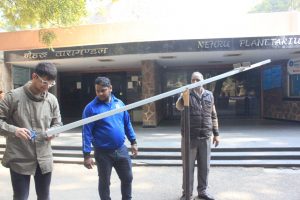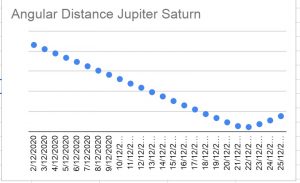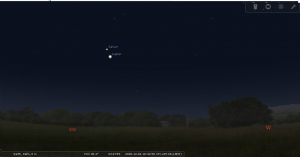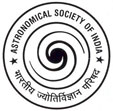A Crosstaff for a Conjunction
A call for the Samanta Chandrasekhar Challenge
By now, many may have heard about the upcoming Great Conjunction of Jupiter and Saturn, on the 21st of December 2020. A very useful article in this connection, by Arvind Paranjpye, Director, Nehru Planetarium, Mumbai, is here https://skytonight.wordpress.com/2020/11/30/the-great-conjunction-21-dec-2020/. He discusses in detail, about the naked eye and telescopic viewing aspects of this conjunction.
The excitement will be at fever pitch on that evening, and rightly so. Those who are lucky enough to be able to access a telescope, will have the best views of the event, if they also have clear skies. A pair of moderate binoculars will at least show the two objects separately, even if any details of Jupiter moons etc. are not visible, while naked eye may show it as one object or at best, Saturn barely resolvable as a separate object. If you do not have access to a telescope and are unable to go somewhere to get access, do not despair. The event is unfolding right in front of our eyes with naked eye visibility for now, even as we are discussing here.
In the days leading to it, someone with an interest in Astronomy, but, not having access to a telescope, can go very hands-on with this conjunction, using simple hand made equipment. This is a good exercise to undertake in the coming fortnight and prior to the actual event, even for those with access to sophisticated telescopes and imaging equipment.
The inspiration to undertake this comes from none other than Pathani Samanta Chandrasekhar, the great classical astronomer of modern times, in India. Samanta Chandrasekhar was a late 19th century astronomer in the Siddhantic tradition, who excelled in making simple handmade instruments with readily available materials, and undertook accurate positional astronomy observations with them. Please see http://articles.adsabs.harvard.edu/pdf/1998BASI…26…33N
The call is to you, anyone school/college/university student or anyone who has an interest in Astronomy, and would like to get their beginner hands on IT.
The Task is for you to make this very simple instrument, a Crosstaff, and measure the changing angle between Jupiter and Saturn over the coming fortnight and submit your measurements for the Samanta Chandrasekhar Challenge. This instrument has been extensively used by Samanta Chandrasekhar, and he has referred to it as Manayantra.
Appendix I will help those who have never seen any of the naked eye planets in the sky. There are many digital supports now available and discussed here, for you to easily be able to locate Jupiter and Saturn in the sky for this project, and also take off from there towards enjoying skygazing, on your own.
Do not be intimidated by the name of the instrument mentioned above, which you have to make, it is one of the simplest and, at the same time, finest of historical measuring instruments in Astronomy.
A simple way of making this using two rulers or sticks, some cardboard and rubber bands is given here https://pwg.gsfc.nasa.gov/stargaze/Scrostaf.htm
At the Nehru Planetarium, Nehru Memorial Museum and Library, New Delhi, we are working on a very looooong crosstaff indeed, to test possible accuracies with stretching this instrument to the limit. The thing is, we will be dealing with very small angles, as we approach closer to the date of the conjunction, and better least count of measurement would be needed.

There may be many simple ways of constructing this, which you could try out yourself, searching for DIY Crosstaff on Google may yield many a site with some handy tips to make this. At the heart of this, is the good old right angled triangle we use for measuring heights and distances, now being applied to measure angles in the sky.
The Geometry for this Measurement

If you have undertaken the measurements with the Crosstaff, tabulate your measurements as follows (doing multiple measurements will yield better accuracy).
You have to measure “b” and “2a”
The angular separation between the two objects (in this case Jupiter and Saturn) is approximately 2a/b or more exactly, 2 *tan-1(a/b)
Measure these and tabulate as follows:

Name and contact – Mob/email :
Remember to take as many observations as possible, to reproduce this theoretical curve of these changing angular distances.

Each day, if you wish, take a number of observations around the same time and average the value you get as the data point for that day, and repeat for as many days as possible.
You could make a Google document with your observations and share the same with nehruplanetarium@gmail.com this will help you obtain some discussion help as you go along with the challenge. You could also join the whatsapp group https://chat.whatsapp.com/DW9lUCb7eGX468aBeKLrwb to discuss with others who are doing this.
There may be some issues which will be faced as the two planets start converging together and the angle becomes smaller and smaller making you want to make your crosstaff longer and longer 🙂 Let us work together to see what innovations we could come up with, to meet this challenge.
All those who submit at least 3 reasonable observations of the changing angular separation between Jupiter and Saturn taken with such simple equipment (add pictures of the equipment constructed), will receive a merit certificate and some selected winners of the challenge will be invited to be a part of a “Meet the Astronomers” program online which will be conducted by the collaborative below.
Samanta Chandrasekhar Challenge
Call given by:
The Public Outreach and Education Committee, Astronomical Society of India
Nehru Planetarium, Nehru Memorial Museum and Library, Delhi
Homi Bhabha Center for Science Education
Science Popularization and Public Outreach, TIFR Mumbai
Shristi Astronomy
Thapar Amateurs Astronomers society, TIET
RSC & Planetarium Calicut
IUCAA Scipop
Department of Physics and Astrophysics, University of Delhi
Pathani Samant Chandrasekhar Planetarium, Bhubaneshwar
IIT, Indore
Indian Institute of Astrophysics (IIA), Bangalore
National Institute of Advanced Studies – Advanced Learning Centre
…. (please send a mail to nehruplanetarium@gmail.com letting us know that you would join the collaborative, and send out the call for the challenge, urgently)
Resources
https://pwg.gsfc.nasa.gov/stargaze/Scrostaf.htm
Acknowledgements
To Ramesh Chikara and Naresh Kumar of Nehru Planetarium, Nehru Memorial Museum and Library, New Delhi for various innovations in designing a host of crosstaffs. To Patrick Das Gupta, Department of Physics and Astrophysics, University of Delhi, for discussions towards possible causes of errors in measurements. To everyone in the collaboratory, for dissemination.
Appendix I
This is for those who may not yet have ever seen Jupiter and Saturn in the sky.
(Coming up soon)

A view of the sky towards South West for the evening of 4th Dec, screen capture from stellarium. This may help those who need some guidance to locate these objects in the sky.
Follow our ASI-POEC Youtube channel for more information in all regional languages:
Discussion in a number of Indian languages, related to the Samanta Chandrasekhar Challenge as follows:
Gujarati—https://youtu.be/99UUdUkDo48
Ladakhi —https://youtu.be/C-Mk6jsfmMw
Marathi —https://youtu.be/PgJFSfKGXjc
Punjabi —https://youtu.be/v3RDuxnIB7I
Tamil —https://youtu.be/8TcOVjYduA8
Telugu —https://youtu.be/N2RDISLPEK8
